- About us
- Love Learning
- Class Pages
- Early Years Foundation Stage (Pre School & Reception)
- Pre School Bunnies
- Love Learning
Love Learning
Helping my Pre-School child
Most pre-school children are fascinated by books, sounds and letters and parents are keen to support and encourage this. However, many people are unsure about how children will be taught to read in schools (It’s not like it was in our day.) and are concerned that they don't want to do anything that may confuse or disadvantage their children in any way.
Don't worry. Anything that you do to develop your child’s love of language is a good thing. If you are looking for specific ideas, there are lots of starting points here.
There is no need to try to teach children phonics before they start school. However there is lots that you can do as a parent to help them be really ready for phonics when they do start school. In a nutshell: read lots of books, listen to all kind of sounds, make all kinds of sounds and talk about all kinds of sounds.
Phase 1 is all about developing these pre-phonics skills. There are many ideas below for developing these skills at home. None of these need to be planned or formal or a big deal. They are just little things that can be added into everyday play with your child.
Being aware of sounds all around us
Toy sounds When your child is playing with their toys encourage them to make the right sounds. Farm animals, train sets, vehicles, dolls etc are great for this. Help your child to notice these sounds around and about. E.g. Listen to the sound that cars, trucks and fire engines make in the street. Practise making these noises, then use them with car, truck and fire engine toys.
Big ears Cup your hands around your ears and listen to sounds all around. Talk about what sounds you can hear. Try doing this in the house, in the street, on a bus (if you don't feel too silly), in the park, on the beach etc. Talk about the sounds: Are they loud or quiet? Are they short or long? Can you make a similar sound with your voice?
Experiment with musical instruments
Shake it all about - Make simple shakers by filling plastic bottles or tubs with rice, pasta, pebbles etc. Play with them and talk about the sounds that they make. Are the sounds soft, sharp, smooth, jiggly, scratchy?
Tap it out - Use the shakers above or use drums (pots and pans and wooden spoons are perfect) to play along with songs, rhymes and the radio. Try making the loudest sounds that you can then the quietest sounds that you can. Tap out simple rhythms. Can your child repeat the rhythm back to you?
Interesting instruments- If you see or hear instruments being played either in real life or on TV, talk about the sounds that the instrument makes. Which instruments does your child like the sound of best? Can they tell you why? Can they imitate the sound with their voice?
Making sounds with our bodies
Song time- I couldn't remember the words of any toddler songs or rhymes when I first became a mum (I used to sing football chants instead to start with) but there are great books and CDs to get you started and it’s amazing how much will come flooding back to you from your own childhood. Encourage children to use their bodies to make sounds to go along with their singing stamping, clapping, patting knees etc.
Sound effects- Read stories and encourage children to make sound effects with their body stomping, knocking, clapping, scratching etc.
Playing around with rhythm and rhyme
Rhyming books - This is the time to bring out your inner performer and have as much fun as possible using silly voices, making sound effects and showing as much emotion as you can on your face (your child probably won't be looking at your face but they will hear this coming through in your voice). Encourage your child to join in as much as possible. You may want to develop your own actions, sound effects etc. There is no need to buy loads of books. Most children love having the same books repeated over and over and whenever you feel the need for a change there is always the library.
When children are really familiar with a particular book, try pausing before the rhyming word. Encourage your child to fill in the missing word.
Clap it out- Encourage children to think about the rhythms in words. Say simple nursery rhymes and clap along with one clap for each syllable. Repeat with knee taps, head pats or stamps.
Listen out for the same sounds (alliteration)
Talking about toys - Talk about your child’s toys and say something about them that alliterates. It doesn't have to make much sense.
Thomas the train travels on the tracks.
Lion likes to lick lollies.
Hippo huddles and cuddles me with his hairy head.
Can your child make suggestions? This is a tricky skill and it will take time. Praise them for trying and making suggestions even if they don't alliterate.
Quick draw - When drawing together, try drawing a snake and a sock. Point out that these things both begin with a ‘s’ sound. Make the hissing s sound. If you say the name of the letter ‘ess’ it won't make as much sense to your child as the words aren't pronounced essnake or essock. Add some more ‘s’ pictures e.g. snail, spider etc. Your child may be able to suggest some ideas as well.
Experimenting with voice sounds
Voice play - Encourage your child to use their voice to make a wide range of sounds. E.g. At the park:
Going up a ladder clunk, clunk, clunk
Coming down a slide whoosh
On a roundabout wheee
Digging in the sand ch ch ch
Bouncing a ball boing
Pulling faces - Play around with moving your mouth in different ways e.g waggling your tongue, opening as wide as possible, smiling wide, frowning, blowing lips etc. You may want to do this to music or it can be a fun bath time game. Make a range of sounds e.g oo, ee, sh, th. Exaggerate your mouth shape while you are doing this to encourage your child to copy your mouth shape. It can be fun to do this while you are both looking in a mirror.
Starting to split words into sounds (segmenting) and put sounds together to make words (blending)
Robotic talking - Words are made up from sounds (called phonemes) and children need to be able to hear these sounds individually. Sometimes when you are playing you can say words as if you were a robot (saying the sounds separately) and see if your child can work out what you are saying. Stick to short simple words that only have a few sounds in them. Make sure you are saying the letter sounds (p-i-g) not the letter names (pee-eye-gee). If you aren't sure what the sounds are or how to break that word down then just miss out that word and pick something easier. E.g.
Pass that p-i-g to me.
Sit d-ow-n.
Point to your t-ee-th.
Hop like a f-r-o-g.
As your child becomes familiar with this robot talking, see if they can say words in robot talk themselves?
Books, books and more books
Always remember that phonics is just a means to an end. We only teach phonics to help our children learn to read and write and in order to do this successfully they need to love books. The most important thing to do with your child is to read as many books as possible. Read anything and everything that you’re child is interested in (including catalogues, take away menus etc). You don't have to read all (or any) of the words each time. Remember to use silly voices, make sound effects, pull faces, act things out, talk about what you can see, talk about what you both think and feel and generally have a whale of a time.
Many children will be curious about letters before they even start school. If a child asks, What is this and points to a letter? , some parents may feel unsure about whether to use letter names or sounds when answering them. Basically, it is probably best to say whatever you personally feel most comfortable with. It can be tricky to learn to say some of the phonemes (sounds) accurately without a bit of training but if you feel confident then go for it, it won't do any harm if you don't get them perfect to start with. Once children have started school, they will soon be learning the sounds they can make (and will probably start telling you what they are instead of asking you).

